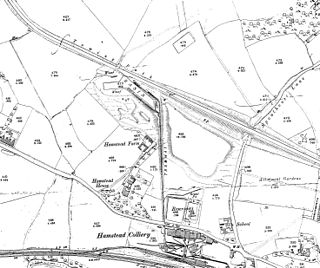A mining accident is an accident that occurs during the process of mining minerals or metals. Thousands of miners die from mining accidents each year, especially from underground coal mining, although accidents also occur in hard rock mining. Coal mining is considered much more hazardous than hard rock mining due to flat-lying rock strata, generally incompetent rock, the presence of methane gas, and coal dust. Most of the deaths these days occur in developing countries, and rural parts of developed countries where safety measures are not practiced as fully. A mining disaster is an incident where there are five or more fatalities.

Chesterton is a former mining village in the unparished area of Newcastle-under-Lyme, in the Newcastle-under-Lyme district, in Staffordshire, England.

Audley is a large village and former civil parish, now in the parish of Audley Rural, in the Newcastle-under-Lyme district, in Staffordshire, England. It is the centre of Audley Rural parish, approximately four miles north west of Newcastle-under-Lyme and 3 miles from Alsager near the Staffordshire-Cheshire border.

Dilhorne is an ancient parish and village in Staffordshire, three miles from Cheadle and six miles from Stoke-on-Trent. The village is within the Staffordshire Moorlands area.
Leycett was a small mining village in Staffordshire in the Borough of Newcastle-under-Lyme which was built in the late eighteen sixties to accommodate the miners and their families. Population details as taken at the 2011 census can be found under Madeley with the name Leycett meaning 'the clearing in the woods'.
The South Yorkshire Coalfield is so named from its position within Yorkshire. It covers most of South Yorkshire, West Yorkshire and a small part of North Yorkshire. The exposed coalfield outcrops in the Pennine foothills and dips under Permian rocks in the east. Its most famous coal seam is the Barnsley Bed. Coal has been mined from shallow seams and outcrops since medieval times and possibly earlier.

Apedale Hall was a manor house near Newcastle-under-Lyme in Staffordshire, it was rebuilt in 1826 by the Heathcote family in the Elizabethan style by British Industrialist Richard Edensor Heathcote,, but was demolished in 1934, due to subsidence from the coal mines underneath.

Chatterley Whitfield Colliery is a disused coal mine on the outskirts of Chell, Staffordshire in Stoke on Trent, England. It was the largest mine working the North Staffordshire Coalfield and was the first colliery in the UK to produce one million tons of saleable coal in a year.

The North Staffordshire Coalfield was a coalfield in Staffordshire, England, with an area of nearly 100 square miles (260 km2), virtually all of it within the city of Stoke on Trent and the borough of Newcastle-under-Lyme, apart from three smaller coalfields, Shaffalong and Goldsitch Moss Coalfields near Leek and the Cheadle Coalfield. Coal mining in North Staffordshire began early in the 13th century, but the industry grew during the Industrial Revolution when coal mined in North Staffordshire was used in the local Potteries ceramics and iron industry.

The Cheadle Coalfield is a coalfield in the United Kingdom. Centred on the town of Cheadle, Staffordshire and its outlying villages it lies to the east of Stoke-on-Trent and the much larger North Staffordshire Coalfield. The area has been mined for many years, with documentary evidence from Croxden Abbey citing coal mining in the 13th century.
The Minnie Pit disaster was a coal mining accident that took place on 12 January 1918 in Halmer End, Staffordshire, in which 155 men and boys died. The disaster, which was caused by an explosion due to firedamp, is the worst ever recorded in the North Staffordshire Coalfield. An official investigation never established what caused the ignition of flammable gases in the pit.

The Knockshinnoch disaster was a mining accident that occurred in September 1950 in the village of New Cumnock, Ayrshire, Scotland. A glaciated lake filled with liquid peat and moss flooded pit workings, trapping more than a hundred miners underground. For several days rescue teams worked non-stop to reach the trapped men. Most were eventually rescued three days later, but 13 died. The disaster was an international media event.

Hamstead Colliery in Hamstead, England, produced coal between 1878 and 1965, by mining the South Staffordshire 'Thick' coal seam. It suffered a major fire in 1908 in which 26 men died.

The Lancashire Coalfield in North West England was an important British coalfield. Its coal seams were formed from the vegetation of tropical swampy forests in the Carboniferous period over 300 million years ago.
Ferndale Colliery was a series of nine coal mines, located close to the village of Ferndale, Rhondda Cynon Taf in the Rhondda Valley, South Wales.

The Forest of Dean Coalfield, underlying the Forest of Dean, in west Gloucestershire, is one of the smaller coalfields in the British Isles, although intensive mining during the 19th and 20th centuries has had enormous influence on the landscape, history, culture, and economy of the area.
Halmerend railway station is a disused railway station in Staffordshire, England.

Garth is a village in Bridgend County Borough, Wales. Garth is situated to the east of the town of Maesteg, and lies at the northernmost end of the Llynfi Valley. During the 19th century Garth was an industrial coal-mining village which contained its own colliery, the Garth Merthyr Colliery.
The Sneyd Colliery Disaster was a coal mining accident on 1 January 1942 in Burslem in the English city of Stoke-on-Trent. An underground explosion occurred at 7:50 am, caused by sparks from wagons underground igniting coal dust. A total of 57 men and boys died.
The Diglake Colliery Disaster, was a coal-mining disaster at what was Audley Colliery in Bignall End, North Staffordshire, on 14 January 1895. A flood of water rushed into the mine and caused the deaths of 77 miners. Only three bodies were recovered, with efforts to retrieve the dead hampered by floodwater. 73 bodies are still entombed underground.









